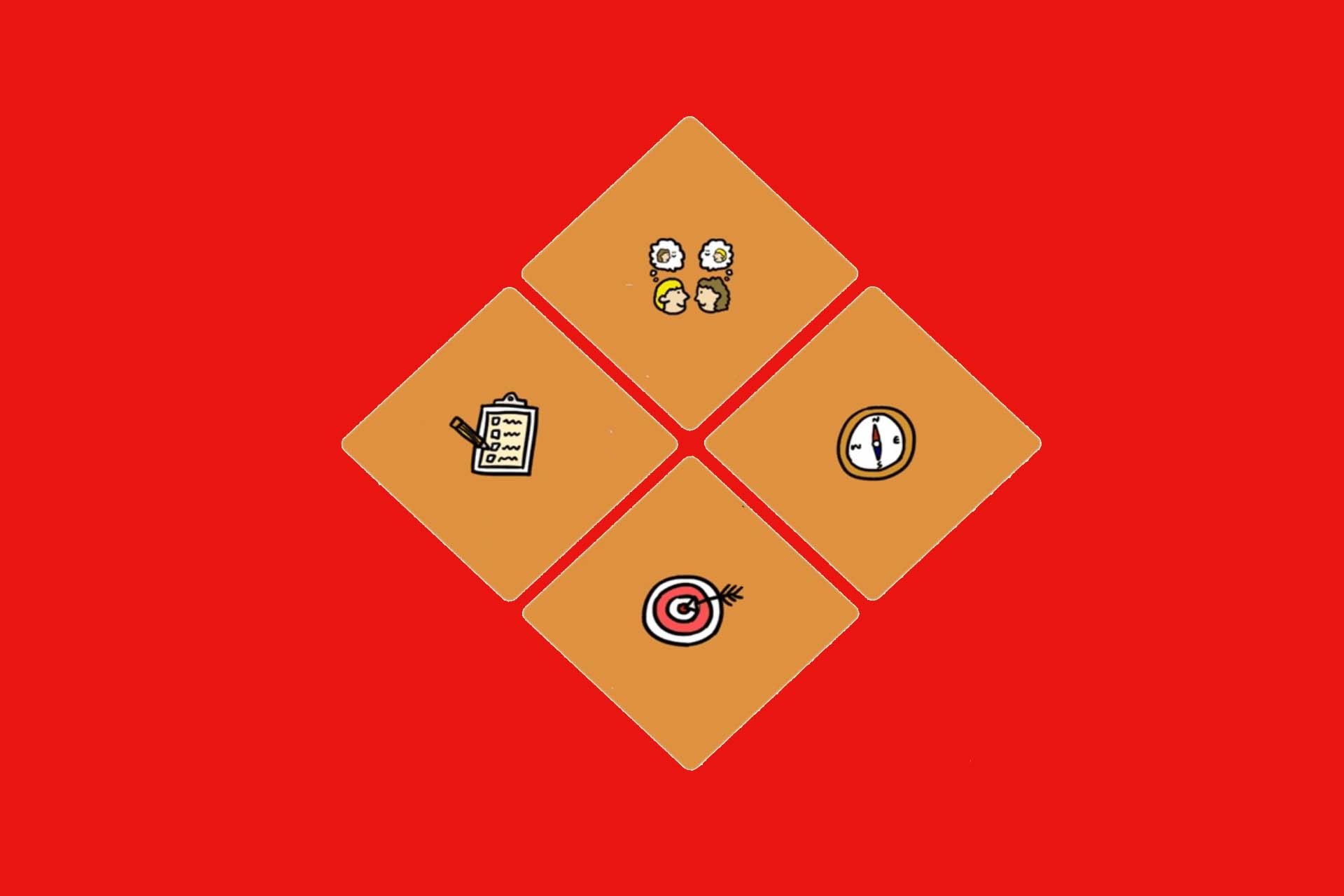Tuckman was wrong – what nonsense!
- “Tuckman was wrong!”
- “Tuckman was disproved, then I’ll just leave that model alone and use another one!”
- or “Tuckman himself warned …!”
Again and again I read such tweets and comments. They refer to Tuckman’s model of team development. I have always found the model very conclusive and helpful, but had never read his study in the original, only what the net knew to tell about it. But what did Bruce W. Tuckman actually do and say and where do these critical comments come from?
What did Tuckman actually do?
Tuckman published an article in 1965 on “Developmental Sequence in Small Groups!” His aim was to “review the literature dealing with developmental sequence in small groups, evaluate this literature as a whole, extrapolate general concepts about group development, and suggest fruitful areas for further research.” [BT, 384]
He analysed what science had found out on the subject since the late 1940s and formulated the famous
- Forming,
- Storming,
- Norming and
- Performing,
now known as Tuckman’s stages of team development.
As a serious researcher, he naturally also listed the limitations that arose for his model from the analysed texts themselves:
- Slightly more than half of the 50 literatures he analyzed dealt with therapy groups and only about a quarter each with training groups and with natural and laboratory groups, respectively. Therefore, a certain caution is necessary when generalizing the results. [“Furthermore, the inequality of setting representation necessitates caution in generalizing from this literature. Generalization must, perforce, be limited to the fact that what has been presented is mainly research dealing with sequential development in therapy groups.”] [BT, 395]
- The majority of the authors would have recorded their qualitative observations and then structured them. Tuckman therefore pointed out the need for methodological considerations for a clean quantitative evaluation of group processes.
- The researchers only ever observed individual and very different group constellations. Thus, it was not possible to filter out the influence of different independent variables on the group process. Here he saw great potential for research.
So, all of this is not useful? Yes, of course it is!
“The suggested stages of group development are highly visible in the literature reviewed. The fit is not perfect, however.” [BT, 397]
A concept for the step-by-step development of teams
Tuckman wanted to formulate a general concept for the step-by-step development of teams that is also suitable for supporting teams in their own development. Therefore, he went into the background of the individual phases very intensively. He distinguished between two dimensions:
- How the team members find each other (development of the group structure) and
- how they solve a task together (task activity).
“Groups initially concern themselves with orientation accomplished primarily through testing. Such testing serves to identify the boundaries of both interpersonal and task behaviors. Coincident with testing in the interpersonal realm is the establishment of dependency relationships with leaders, other group members, or preexisting standards. It may be said that orientation, testing, and dependence constitute the group process of forming.
The second point in the sequence is characterized by conflict and polarization around interpersonal issues, with concomitant emotional responding in the task sphere. These behaviors serve as resistance to group influence and task requirements and may be labeled as storming.
Resistance is overcome in the third stage in which ingroup feeling and cohesiveness develop, new standards evolve, and new roles are adopted. In the task realm, intimate, personal opinions are expressed. Thus, we have the stage of norming.
Finally, the group attains the fourth and final stage in which interpersonal structure becomes the tool of task activities. Roles become flexible and functional, and group energy is channeled into the task. Structural issues have been resolved, and structure can now become supportive of task performance. This stage can be labeled as performing.
Although the model was largely induced from the literature, it would seem to withstand the test of common sense as well as being consistent with developmental theory and findings in other areas.” [BT, 396]
A model is a model
Tuckman further suggested that the lifespan of a group influences the scope and speed of development. Accordingly, the storming phase is very short, if it takes place at all. In long-lived therapy groups, on the other hand, there is no such compulsion to rush development; on the contrary, working through emotional resistance is part of the task.
“The value of the proposed model is that it represents a framework of generic temporal change within which the above explorations can be nested, and which should lead to the derivation of many specific hypotheses relating independent variables to the sequence of temporal change. Such quantitative explorations will undoubtedly lead to refinements and perhaps major modifications of such a model.” [BT, 398]
He later adds one more refinement to the model himself. In the 1977 article “Stages of Small Group Development Revisited”, Tuckman and Mary Ann C. Jensen point out that later empirical studies name yet another, fifth stage of separation and abandonment, adjourning. [TJ]
Where does the warning about Tuckman’s model of team development come from?
So where does this “Tuckman himself warned…” come from?
The quote “However, Tuckman (1965) warned researchers that the application of this model to generic team settings may be inappropriate since the majority of his data came from the population of therapy groups and human relations training groups.” is found in Pamela J. Knight’s 2006 research paper on “Small, Short Duration Technical Team Dynamics”. [PK, 5]
Well, I did not find this dramatic formulation in Tuckman’s papers.
And Knight added during a presentation of the results at the same place in 2007 that these types of groups do not fit at all to the team settings they are dealing with: “Note that the types of groups from which the Tuckman model was derived have almost nothing in common with the technical groups supporting DoD acquisition.” [PKS, 75]
“DoD acquisition” is the procurement unit of the US Department of Defense, with 133,000 employees at the time, dealing only with procurement projects, always in small, cross-functional, short-lived teams.”
Pamela J. Knight taught procurement management as a professor at the DoD’s university, among other things, with a career as a physicist and engineer, military intelligence data analyst, IT specialist, missile engineer and experienced programme manager. (Tuckman, incidentally, had developed his study at the Naval Medical Research Center, Bethesda, ML). So with that background and in that capacity, she found that they were working with a team development model that no one had yet empirically tested and that obviously didn’t fit the teams they were working with at all. And consequently she arrived at a very obvious question: “Do the members of a missile design team interact in the same way as the members of a psychiatric therapy group?” [PK, 6]
Maybe, maybe not?
A remarkable study by Pamela J. Knight
Subsequently, Pamela J. Knight and her students launched a remarkably extensive field study, including a mathematical evaluation model, to arrive at reliable data for the training and work of procurement teams: 321 test teams with 1,448 people and average team sizes of 4-5 participants.
The convincing result: the storming phase [almost] does not take place in the given test environment. She turns this into the three-stage DAU team dynamics model with Forming, Norming and Performing, which technical teams follow as a result of this research. (DAU stands for her employer, the Defence Acquisition University).
Convincing? Yes. But surprising? No, because Tuckman himself had pointed out that variants can occur under certain conditions.
Knight saw three possible reasons for the absence of the storming phase:
1. the team size
- small, 4-8 people
2. the duration of the team activities
- short, maximum 20 hours, median 4 hours
3. the team environment
- Academic environment,
- presence of the trainer during the team exercises and his or her subsequent grading of the participants’ behavior.
Regarding the last sub-item, she formulated, “This is analogous to a natural team when “management” is a part of the team or closely monitors the team. Cooperative professionalism is encouraged while conflict, resistance, and hostility are often discouraged whenever a neutral authority with significant power over the team members is observing the process. In other words, team members may have been exhibiting their best professional behavior rather than the less politically correct behavior they might have exhibited within a group of peers. Certainly, “resistance to the task” would be muted in the presence of the instructor who assigned the task and who was going to grade the task products.” [PK, 58]
That’s one way to describe it. I would definitely add to the team environment the culture of a strictly hierarchical organisation.
However, Knight’s final conclusion on the process of team development was, “In summary, a comparison to (some other) data suggests that the lack of Storming within the DAU data is not an attribute of team size or duration. Thus, it is suspected that the lack of Storming is a natural attribute of technical professionals working under time constraints to produce good-quality products for which they are held collectively responsible”. [PK, 92]
No Storming at CRUScH
Small insertion: Interestingly, Alexander Gerber and I hardly experienced a storming phase during our Crazy User Story Challenges CHRUScH for product and team development. The simulation runs for just under 7 hours, including 3 x 1 hour of direct teamwork to produce a product, with 5-7 people who are complete strangers to each other.
Our interpretation for this, besides the short duration of the experiment, was the lack of social debts and obligations to each other. There was no common past and no common future to guide one’s behavior. The only thing that counted was the collective result to be achieved and the sting of technical expertise.
And that is how fantastic solutions always emerge.
Team development as a solution?
Pamela J. Knight also concluded on the basis of her data that these DAU teams, which only work together for a very short time, “produce better products than teams that do not follow this model” [PK 94], i.e. go through a storming phase.
Their conclusion: “It may, therefore, be possible to significantly improve productivity in technical teams by facilitating the DAU model—that is, to encourage teams to first coalesce as a team and form their intent and structure; then develop their approach, ground rules, and processes; to be followed by assigning tasks and getting the work done—all the while cooperatively challenging, re-evaluating, and improving the overall team process as they work together to accomplish the task they were given.” [PK, 94]
Team building and team development are the magic words, we know that from somewhere.
And here is where it is wrong to eliminate the storming phase from the process just because it does not happen or goes almost unnoticed in certain situations.
To do this, let’s return to the passage where Bruce W. Tuckman explains the WHY of his model:
“This model was aimed at serving a conceptual function as well as an integrative and organizational one.” [BT, 396]
We have now thought long enough about the conceptual part. The integrative and organisational function means providing assistance to all those who want to actively engage with the dynamics of team development.
Tuckman gives a very differentiated description of the psychological background of the activities in the individual phases and also refers to other areas of research with interesting insights into the developmental processes of human beings. Together with Lencioni’s “5 Dysfunctions of a Team”, one has a very exciting master plan for the development of a team.
It helps to understand what the differences in conflicts are in the individual team phases and how one should deal with them. How, for example
- how to understand attempts to contact the leader of the event (whoever is seen as such),
- what the formation of groups means,
- what the existence of a “scapegoat” means and how one should react to it.
It helps to know and recognise all this.
If I have no idea what storming or any of the other phases are for, how to recognise them, how best to respond to certain behaviours, then I cannot support my team as a Team Leader, Product Owner, Scrum Master or Team Member.
Therefore, Tuckman got it wrong – such nonsense!
Notes:
If you like the post or want to discuss it, feel free to share it with your network.
- Bruce W. Tuckman: Developmental Sequence in small Groups, Psychological Bulletin 1965, Vol. 63, No. 6, 384-399 [BT]
- Bruce W. Tuckman & Mary Ann C. Jensen, Stages of Small-Group Development Revisited Group & Organization Studies, December 1977, 2(4),419-427, Copyright © 1977 by International Authors, B.V. [TJ]
- Pamela Knight, Acquisition Community Team Dynamics: The Tuckman Model vs. the DAU Model, April 30 Pamela Knight, Small, Short Duration Technical Team Dynamics, Final Research Report, May 2006, Defense Acquisition University Press, Fort Belvoir, VA [PK]
- Pamela Knight, Acquisition Community Team Dynamics: The Tuckman Model vs. the DAU Model, 30 April 2007, Defense Acquisition University, 4th Annual Acquisition Research Symposium, Wednesday Session [PKS]
Conrad Giller has published other articles on the t2informatik Blog, including:

Conrad Giller
Conrad Giller has been working for about 30 years as a trainer, coach and consultant for almost all challenges of oral communication: conflict, team, leadership, storytelling, presenting, moderating, media, etc. He is happy to pass on his experience online and offline in workshops.


